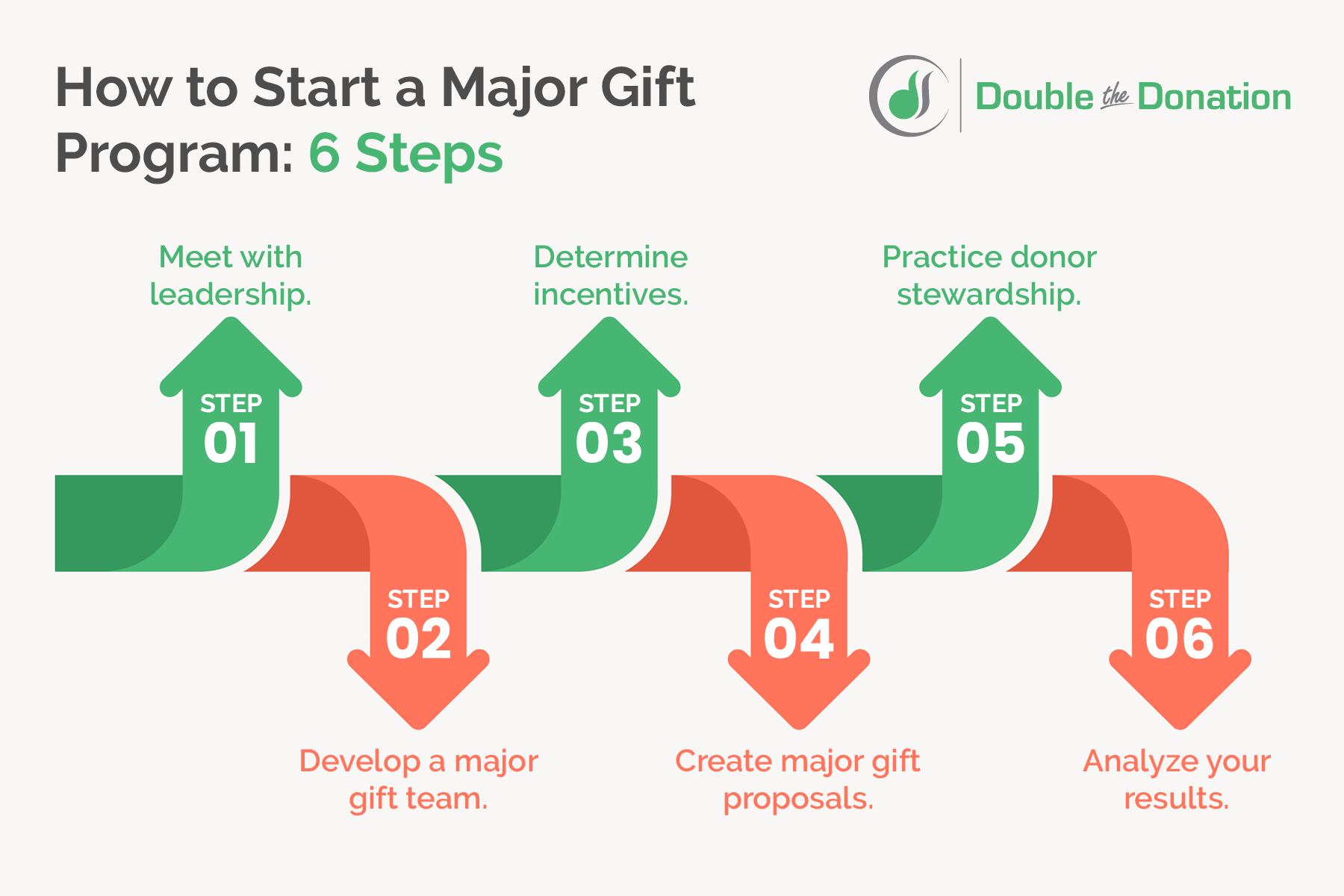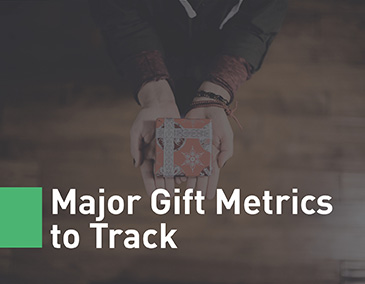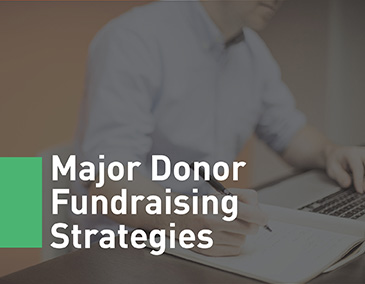The Basics of Major Gifts
What are Major Gifts?
The definition of what constitutes a major gift differs from organization to organization. A small nonprofit might deem a major gift as anything over $1,000 while a large, well-established organization might call $50,000 a major gift. Outside of planned giving, major gifts are the largest donations that a nonprofit receives. However, they are not granted frequently.
Why are Major Gifts Important?
Because major gifts are often some of the largest donations that an organization receives, their importance cannot be overstated. Your nonprofit can boost its fundraising efforts when you take the time to cultivate, solicit, and steward your major gift donors properly. Major gifts only appear once in a while. Make sure your organization is prepared for them.
How to Ask For Major Gifts?
Major gifts don’t just fall out of the sky. Asking for major gifts takes more time and patience than donation appeals for smaller contributions. Once you have a relationship with a potential major gift donor, all you have to do is make your case and pitch the appeal. Forming that connection, though, is crucial to major gift success.
Major Gift Statistics for Small and Mid-sized Nonprofit Organizations
of registered charities in the U.S. raise $10 million or less annually.
of total donated income comes from major gift fundraising.
The median donation amount which nonprofits classify as representing a major gift.
The mean number of donors organizations raising less than 10MM annually are cultivating for a first gift.
Sources: Amy Eisenstein, DonorSearch, Bloomerang
The Major Gift Process
The path leading up to receiving a major gift is not a quick and easy route. Because major gifts are substantial donations made by a single person (or family), they require more attention and cultivation than a smaller contribution would. But have no fear! We’ve broken the process down into four subsections to help you reach major gift success.
Research Your Major Gift Donors
Ability to Give
Property Ownership
Donors who own more than $2 million in real estate are 17 times more likely to give philanthropically than those who do not. By doing some research on property ownership, your nonprofit might uncover your next potential major donor.
Political Giving
People who give substantial amounts of money to political campaigns clearly have the funds to donate to a nonprofit. In fact, studies have shown that donors who give over $2,500 in FEC and charitable campaigns are 14 times more likely to give a charitable contribution than those who do not.
Stock Ownership
Over 55% of Americans hold stock in publicly traded companies. Ask contributors to donate stock to charity, also known as a securities donation, because it is up to 37% more tax effective than cash and can yield more in gifts. Also, advise donors to directly contribute stock over using donor-advised funds, or DAF, which may delay when the nonprofit will receive the gift.
Willingness to Give
Past Giving
Someone who has donated to your organization in the past is likely to make a donation in the future.
Even if an individual hasn’t previously donated to your nonprofit, they will be more inclined to give in the future if they have a tendency to donate to other institutions.
Size of Past Donations
Someone who donates $10 to your organization every month might not be as strong of a major giving candidate as someone who donated $1,000 a year ago. Examine past donation amounts and look at giving trends as well.
Connection to Your Organization
Donors who have a positive relationship with your nonprofit can be fitting candidates for major giving. When paired with other philanthropic and wealth markers, a donor’s connection to your organization can be a good indicator of major giving.
Cultivate Your Major Gift Donors
An In-Person Meeting
Major gift donors deserve special care and attention if they are expected to donate a significant amount of money to your organization. An in-person meeting is a good first step in making connections with your major gift prospects and introducing them to your organization.
Follow-Up Communications
After your initial meeting with a prospect, follow up with additional communications. Include the prospect on your email newsletter list and send them personalized correspondence. Direct mail is a particularly effective, professional way to begin your follow-up. Ensure your messages are attractive, high-quality, and personalized to make the best impression possible.
Event Invitations
Major gift prospects like to know that their money will be spent on worthwhile endeavors. Inviting your major gift prospects to events will allow them to meet other donors and more of your nonprofit team, helping them form a more complete picture of your organization and your mission.
More Meetings
Meet with your major gift prospects after the initial meeting to further develop your relationship with them.
Ask Your Major Gift Donors
Formulate a Figure
During the research and cultivation stages, you should have determined a ballpark amount that would suit your major gift prospect. Make sure that this figure is correct—too high and you put your donor in an awkward position; too low and your organization leaves money on the table.
Practice the Ask
Before you walk into your solicitation meeting, you’ll want to practice the conversation. Pair up with a coworker and practice the different ways you might go about asking for a donation. Additionally, you should prepare (but not memorize!) some key notes and phrases to use during your meeting.
Prepare for Questions
You have to be prepared for negative or ambivalent answers. Even if you have the best research, cultivation, and solicitation strategies in the world, a donor might not be ready to give. If you receive a “Maybe,” “Not now,” or a “No,” offer other engagement opportunities like volunteering or event attendance.
Follow Up With Your Major Gift Donors
Say Thank You
Let your major gift donors know (more than once!) that you appreciate their generosity. If they agree, publicly recognize them on a donor wall, sign, or plaque as well.
Invite Them to Events
In addition to the standard fundraising events that you should be inviting major gift donors to, hold a special get-together for your top-tier givers.
Keep Them in the Loop
If a major donor supported a specific project, give them regular updates on the status of that project. If they gave to the annual fund, give them specific examples of what their money is going toward.
Major Gift Must-Haves
Warriors don’t go into battle unarmed, and your nonprofit team shouldn’t pursue major gifts without metaphorical armor either! We’ve got a list of some must-have essentials to take with you on your journey toward major gifts.
Major Gifts Officer
Qualifications
In general, a major gifts officer should have the following qualifications:
- Familiarity with fundraising.
- Good communication skills.
- Determination to solve problems.
- Familiarity with your nonprofit or similar organizations.
- Connections with major donors and influential community members.
Responsibilities
A major gifts officer spearheads all of the major giving initiatives at an organization and works closely with fundraisers and the prospect research team to determine major giving candidates.
A major gifts officer will be responsible for soliciting some of the largest donations that your organization receives. It is imperative, therefore, that your major gifts officer is comfortable and able to make those appeals and follow up with donors.
Major Gift Metrics
Why You Should Track
Your nonprofit is already likely measuring a whole host of metrics ranging from return on investment (ROI) to matching gift metrics.
Continue that trend and start measuring major gifts metrics!
Measuring major gifts metrics will help you adjust course when something isn’t working like it should be.
What to Track
Some general metrics you should take a look at include:
- The number of asks made.
- The number of face-to-face visits over the course of time.
- How much money you’ve raised with the help of major gifts.
- The percentage of donors or prospects in each stage of the donor pipeline.
Major Gift Calculator
Importance of a Major Gift Calculator
Major gift calculators are essential to successful and strategic fundraising.
They are most useful when your nonprofit has a specific goal in mind and needs to reach that goal in a specified timeframe.
Whether you’re part of a small nonprofit or you play a larger role in an established organization, you can use a major gift calculator to determine how many donations you need at each giving level.
Not every donor is able to give the same amount, and a major gift calculator can help you determine how many donations you need to secure and how you can go about asking for those contributions.
No fundraising methodology is perfect, but a major gift calculator can help you more accurately pinpoint where you need to focus your fundraising efforts.
Example Calculator
Begin with your fundraising goal as your starting point. For simplicity’s sake, let’s assume you need to raise $500,000.
Next, you’ll need to estimate the largest gift you’ll be able to secure. Depending on your organization, this will likely be between 15% and 30% of your fundraising goal. Let’s call it 20%, or $100,000 in this example.
Then, calculate the next highest gift amounts. The easiest way to do this is by halving each consecutive gift level.
So, in our example, the giving levels would be:
- $50,000
- $25,000
- $12,500
- $6,250
Then, assign the number of donations you’ll need for each giving level to reach your goal. In this example, we’ll need:
- 1 donation of $100,000
- 2 donations of $50,000
- 4 donations of $25,000
- 8 donations of $12,500
- 16 donations of $6,250
The idea is to bring in a few large donations and many smaller ones.
Major Gifts and Prospect Research
What Prospect Research Tells You
You can use prospect research to learn more about your donors, major or otherwise. The information from a prospect screening will tell you a donor’s:
- Past giving to your organization, other nonprofits, and political campaigns.
- Business affiliations.
- Real estate and public stock ownership.
- Basic information like name, address, and marital status.
Why You Need Prospect Research for Major Gifts
Looking for your major gift donors without prospect research is like looking for buried treasure without a map. You might stumble upon some hidden treasure chest, but the odds are definitely stacked against you.
Having the information that prospect research can give you can help you determine who your major gift prospects are and how much money you can reasonably ask them for.
Major Gift Fundraising Supplements
Now that you know all about major gifts and know about the various resources that you’ll need, it’s time to go after those major donations! Before you rush out the door and start making donation appeals, ensure that you’re properly prepared with the following major gift fundraising supplements. From fundraising event ideas geared toward major gift donors to online donation tools, we’ve got everything you could need!
Major Gifts and Matching Gifts
Why Pair Matching Gifts and Major Gifts
What’s better than a major donation?
Two major donations!
Major gifts and matching gifts are like the celebrity power couple of the nonprofit fundraising world. They can also be tricky to pin down.
When your major gift donors are aware of matching gift programs, your nonprofit receives two substantial donations. Make sure that you’re promoting matching gifts to all of your donors in general, but especially to your major gift donors.
How to Pair Matching Gifts and Major Gifts
Combine major gifts and matching gifts by:
- Encouraging your major gift donors to look into corporate matching gifts. Even though most companies place limitations on their matching gift programs, those caps are often generous amounts ranging from $15,000 to $50,000. Your nonprofit can stand to potentially receive two major gifts when you let your major gift donors know about matching gifts.
- Asking your major gift donors to start a matching gift program at their company. Many major gift donors either own their own businesses or serve in a leadership position at a corporation. If that company doesn’t already have a matching gift program, you can encourage your major gift donors to put one in place.
Learn more about matching gift best practices in the video below!
Major Gifts and Fundraisers
How to Pair Major Gifts and Fundraisers
If you want to show your major gift donors how you are using their funds and give them a chance to directly interact with each other and your organization, try hosting a fundraising event!
While the underlying purpose of fundraising events is to raise additional money for your nonprofit, they can also be excellent opportunities to connect with your major gift donors.
Fundraising Ideas
Double the Donation has a whole selection of over 200 fundraising ideas that you can host for your donors. These ideas include:
- Quick and easy fundraising ideas for all nonprofits
- Event fundraising ideas
- Fundraising product ideas
- School fundraising ideas
Try hosting a fundraiser to generate more revenue for your nonprofit and get to know your major gift donors a little bit better!
Major Gifts and Challenge Grants
What are Challenge Grants?
Challenge grants are issued by companies and foundations.
They require nonprofits to complete a “challenge” before funds are released.
The challenge in question is usually fiscally-based, meaning that a nonprofit must raise a certain amount of money before being eligible to receive the grant.
Challenge grants also require the nonprofit to give regular updates to the grant-making party.
Pairing Major Gifts and Challenge Grants
Since challenge grants have a timeline attached to them, your fundraising goals must be strategic and purposeful.
What better opportunity to solicit major gift donors?
Because you have a defined goal and a specific deadline, you can research, cultivate, solicit, and steward your major gift donors with your end game in mind.
Major Gifts and Capital Campaigns
Capital Campaigns Explained
A capital campaign is an extended fundraiser that takes place over several years. Nonprofits typically host capital campaigns to raise funds for a specific project or initiative.
Capital campaigns last longer than regular fundraisers because they’re used to raise significant amounts of money. Examples of projects your nonprofit may host a capital campaign for include a new building or land acquisition.
How Do Capital Campaigns and Major Gifts Connect?
Since capital campaigns require a significant amount of funding, major gifts can help nonprofits reach their capital campaign fundraising goals.
Before nonprofits announce their capital campaigns to the public, they have what’s called a quiet phase. This stage in the process is dedicated to securing major gifts to get as much funding as possible upfront.
How to Start a Major Gift Program
It can be daunting to start a major gift program. We’ve broken down the process into six easy-to-follow steps.
1. Meet with leadership.
For your major gift program to be successful, you’ll need to garner the support of your leadership team. Take the time to sit down with members of leadership to discuss the importance of a major gifts program and what you’ll need from them to kickstart the process.
With your organization’s leaders on board, it will be easier to launch your program toward success. They may have connections with major gift prospects that you can leverage. Additionally, you can introduce prospects to your leadership team during the cultivation process so they can learn more about your nonprofit.
2. Develop a major gift team.
As previously mentioned, you should designate a major gift officer to preside over your program. However, for best results, consider assembling a dedicated team for the program.
Potential team members may include:
- Board members
- Fundraisers
- Prospect researchers
- Marketers
This team will carry out the major gift process from beginning to end, including identifying prospects, building relationships for them, soliciting major donors, and developing stewardship techniques.
3. Determine incentives.
When contributing a large sum to your nonprofit, major donors may be more motivated to contribute if you offer recognition or another incentive in return for their generosity. Determine these perks ahead of time so donors know what to expect.
For example, major donors who helped fund your new building expansion may receive a shoutout on your website and a plaque recognizing their contributions.
4. Create major gift proposals.
It’s important to abide by best practices when soliciting major gifts to nurture the relationships you’ve built with prospects. Keep the following tips in mind when creating major gift proposals:
- Personalize your ask. Since you’ve formed relationships with prospects throughout the major gift process, make sure to acknowledge the personal connections you’ve developed. Use prospects’ preferred names and titles in all communications, and reference specific pieces of information they’ve revealed to demonstrate your understanding of each donor as an individual. For example, a prospect may explain that contributing to your organization in the past has made them feel energized to give back to their community. You can use this language in your appeal to show you’ve listened to the prospect during the cultivation process.
- Present options. By providing prospects with multiple campaigns or initiatives they can contribute to, you increase the likelihood that they’ll contribute. When donors can give to projects that they’re passionate about, they’ll feel more satisfied with the major gift process.
- Show prospects the bigger picture. Major gifts don’t just help you develop a new building or program. Ultimately, they allow you to fulfill your mission and help your beneficiaries. Make it clear how a prospect’s contribution will further your nonprofit’s overarching goals.
- Be direct. Using the information you’ve acquired about the donor, make a direct ask. Include the specific donation amount, the initiative the contribution will fund, and why this project needs funding in particular.
To ensure each prospect receives the most personalized ask possible, assign each member of your major gifts team to a specific donor. That way, they can see the donor relationship through from beginning to end, making them the optimal person to solicit a gift.
5. Practice donor stewardship.
One of the most important steps in the major gift process is stewardship. Your major donors contribute significant funds to your organization, so make sure they know you appreciate their support.
Take a strategic approach to donor stewardship. Develop a plan for how you’ll maintain relationships with major donors after your campaign is over. For example, you may set up an automated email cadence that checks in with major donors throughout the year to assess their satisfaction with your organization’s offerings, collect feedback, and invite them to exclusive events and engagement opportunities.
6. Analyze your results.
By setting and following up on key performance indicators (KPIs), you can analyze your results and identify areas for improvement.
For example, let’s say you choose to track average gift size during your campaign. After the campaign ends, evaluate the result. How does it compare to the goal you set at the beginning of the major gift process?
If you met or exceeded your average gift size goal, you may want to increase it for the next campaign to push your major gifts team even further. However, if you underperformed, brainstorm ways that your team can increase the average gift size during your next campaign.
Additional Major Gift Resources
Major Gift Metrics
Interested in learning what types of major gift metrics you should be tracking? Take a look at this resource from SalsaLabs to get in-the-know!
Major Gift Strategies
Major gift fundraising is truly an art. If you’re looking for some pointers, check out this collection of resources from DonorSearch.
Major Gift Officer
Looking to hire a major gifts officer? Learn more about what the job entails by reading through this sample major gifts officer job description.






